PinotFile: 8.22 September 22, 2010
|
Kistler Vineyards Pinot Noir TastingThere is no other iconic winery like it in California. Despite the popularity of social networking as a marketing tool for wineries, you won’t find this winery on Facebook or Twitter. The winery is not open to the public, there is no tasting room, the wines are not poured for tasting at any public wine event or winemaker dinner sponsored by the winery. The wines are only submitted to two wine critics for review, Robert Parker and Stephen Tanzer (Parker’s scores are usually higher!), who both visit the winery annually. The winery was one of the few not included in John Winthrop Haeger’s compendium, North American Pinot Noir, because the winery opted out. The winery does not belong to its appellation winegrowers association. A winery website did not appear until 2005 although the winery was founded over 30 years ago. The wines are sold primarily to consumers through a mailing list based on years of customer loyalty and volume of customer purchases. Minimum purchase is a case of wine with each offering (there is a spring and fall offering), which with tax and shipping can easily top $1,000. If you don’t buy, your allocation will quickly dwindle until you are unceremoniously dropped from the mailing list. Is this anyway to operate a winery in today’s competitive wine business? Winemakers Steve Kistler and Mark Bixler decided early on to direct their energies completely to vineyard management and winemaking, avoid the public eye, and let the quality of their wines speak for themselves. You can’t argue with their business plan, for today they produce 25,000 to 30,000 cases of Pinot Noir and Chardonnay annually (exact figures are not available) that is highly sought after by avid devotees of the Kistler style. Their wines command prices that are among the highest in California ($55 to $120) and Kistler Vineyards is considered the benchmark for California Chardonnay. Robert Parker has stated in The Wine Advocate, “If the Kistler Winery could be magically transported to the middle of Burgundy’s Côte d’Or, it would quickly gain a reputation as glorious as any producer of Burgundy grand crus.” Steve and John Kistler founded Kistler Vineyards in 1978 and released their first 3,500 cases of wine the following year. Mark Bixler joined the winery as a partner and John eventually left. Kistler Vineyards was one of the first California wineries to popularize Chardonnay crafted with traditional French techniques including whole cluster pressing, fermentation with indigenous yeasts, 100% malolactic fermentation in barrel, élevage in 50% new and 50% 1-year-old French oak barrels (aged to the winery’s specifications) in contact with the fermentation lees, minimal handling and processing including no racking, and bottling unfined and unfiltered after 11 to 18 months of barrel age. The Chardonnays were rich and oaky in the early 1990s, but through the years have become more refined with greater complexity and restraint. Currently, there are ten Chardonnay bottlings grown primarily from heritage clones of Chardonnay (including Old Wente), all of which the winery has been raising for thirty years. Very few producers in California work with such a wide range of Chardonnay vineyards, which include sites from western Sonoma County, the Russian River Valley, Sonoma Mountain and Carneros. Back in the early 1990s, I was a regular purchaser of Kistler Vineyards Chardonnay when the winery’s popularity exploded. Along with a lawyer friend, we were buying a few cases every year and our spouses loved the stuff. We had a trip planned to the Russian River Valley and my friend phoned the winery to ask for a tour and tasting. He was able to speak with Mark Bixler. My friend is notoriously persuasive and persistent, keeping Bixler on the phone for fifteen minutes, but he got nowhere. Bixler said, “We don’t have any tasting glasses at the winery.” We often laugh about this story, grumbling about the rejection, even though we were spending thousands of dollars a year for Kistler wines. I have never met anyone who has visited the secluded winery, much less talked in person with the reclusive proprietors. There are a few other enigmatic features of Kistler Vineyards. The wines are not sold on the website. No library wines are available for sale. Magnums have never been produced, or at least, released publicly. A Kistler newsletter from 1994 states that they planned to offer a small portion of their Chardonnay and Pinot Noir in magnums but I am not sure if any were bottled and sold. Mailing list members are given a narrow two week window after the spring and fall offering to buy their allocated wines. Buyers must purchase quite a bit of Chardonnay to receive more than a paltry allocation of Pinot Noir. All the Pinot Noirs I tasted for this feature, regardless of vintage, had a labeled alcohol percentage of 14.1%, a curious detail. A few facts are well known. Steve Kistler received a B.A. from Stanford University, studied at University of California at Davis and Fresno State University and was an assistant at Ridge Vineyards for two years before founding Kistler Vineyards. He is the winemaker and oversees vineyard operations. Mark Bixler received degrees from Massachusetts Institute of Technology and University of California at Berkeley, taught chemistry at Fresno State University for seven years, and worked at Fetzer Vineyards for two years. He shares winemaking responsibilities and is the chemist and business manager for Kistler Vineyards. The first commercial account for Kistler wines was John Ash & Co. restaurant in Santa Rosa. Kistler Vineyards spent its first fourteen years at a winery located on Nelligan Road in Glen Ellen. A new winery was constructed on Vine Hill Road in Sebastopol just west of Santa Rosa’s lowland Laguna in time for the harvest in 1992. The facility is modern and perfectly suited for the vinification of Chardonnay and Pinot Noir. A central feature of the winery is seven large subterranean gravel floor barrel rooms used for aging. The rooms are individually temperature controlled and heavily insulated. The large barrel aging space gives Kistler the ability to leave the wines undisturbed until they are perfectly ready for bottling, a practice common among the top producers of white Burgundy. The large number of refrigerated stainless steel tanks allows Kistler to bottle their wines unfiltered. Jason Kesner, who managed Hudson Vineyard from 2000 to 2008, has served as the assistant winemaker since 2008 and assists in vineyard operations. Ed Hogan is the Director of National Sales. In 2008, a minority stake in the winery was sold to Bill Price, owner of Sonoma Valley’s Durell Vineyard. Kistler has worked with price since 1998 when he acquired the 200-acre Durell Vineyard. With Price’s stake in Kistler, production of Kistler Durell Vineyard Chardonnay has reportedly increased to around 3,000 cases annually. The last several years Kistler has quietly established new vineyards for their Pinot Noir and Chardonnay program. In 2007, Wines & Vines reported that Kistler had begun to plant three new vineyard sites: a five-acre block of Pinot Noir on Taylor Lane across from Summa Vineyard (777 and Calera), 20 acres of Pinot Noir and 10 acres of Chardonnay on Trenton-Healdsburg Road across from Mark West Winery (777, Calera, and some clones of “mysterious origins,” and a 25-acre planting jointly with another winery on a high ridge north of Jenner near Camp Meeting Ridge (various clones including the “mysterious” French clones). Two trends are evident in Kistler’s newer Pinot Noir plantings: vineyard sources have moved to the very cool true Sonoma Coast, and the emphasis is on a diverse mix of clonal plantings with particularly heritage clones such as Calera, and unspecified clones of French origin rather than Dijon clones. Kistler abandoned the Dijon clones of Chardonnay and Pinot Noir in 2003, finding them too productive even on the shallow soils of their sites, and any blocks carrying these clones were re-grafted to California heritage selections or cuttings from vineyards in France planted to “mass selection.” The Calera clone makes up all the Occidental Station Vineyard bottling and a good portion of the Kistler Vineyard Pinot Noir. Kistler Pinot Noir has not gained as much notoriety as Kistler Chardonnay, yet Parker remains quite a fan. He gushed in 2002 in The Wine Advocate, “Steve Kistler and Mark Bixler are justifiably proud of what they have achieved with Chardonnay, but what really turns them on is their accomplishments with Pinot Noir, which may be the greatest Pinot Noirs made in the New World.” The first Kistler Pinot Noir was released from estate grown Russian River Valley grapes in the 1991 vintage. A Sonoma Coast appellation blend has been produced since 1994. A Russian River Valley appellation Pinot Noir was added in 2008. Along with Williams Selyem and Littorai, Kistler was one of the first to bottle Pinot Noir from Hirsch Vineyard, but this was discontinued as a vineyard designate after 2001. Camp Meeting Ridge Vineyard, owned by Flowers, was a favorite of Steve Kistler’s and produced some stunning vineyard designate wines (1994 to 1998). Cuvée Catherine, named after Steve and Cathleen Kistler’s daughter, appeared on Russian River Valley Pinot Noir bottlings primarily or exclusively sourced from Kistler’s Estate Vineyard from 1991 to 2003. The Cuvée Catherine designation was assigned to the single vineyard Occidental Station Vineyard Pinot Noir starting in 2004. Vineyard-designated Cuvée Elizabeth Pinot Noir was produced from Occidental Vineyard in the Sonoma Coast from 1998 to 2003, but this vineyard was acquired by Evening Land Vineyards and is no longer a source for Kistler. The Cuvée Elizabeth designation was transferred to the single vineyard estate Bodega Headlands Sonoma Coast Pinot Noir bottling beginning in 2004. A third vineyard designate from the Sonoma Coast, Silver Belt Vineyard (Cuvée Natalie), debuted in 2006. Cuvée vineyard designated production is variable in amount depending on vintage tonnage, but was about 4,000 cases in the 2008 vintage. A full listing of Kistler Pinot Noir releases from the first in 1991 to the present is included below. The Pinot Noir winemaking (as best as I can summarize from available information) is as follows. An initial extended cold maceration is followed by fermentation in open top fermenters. The free run juice is barrel fermented in 60% to 100% new 3-year air dried French oak barrels. The wines are barrel aged 14-18 months and bottled unfined and unfiltered. The Kistler style of Pinot Noir emphasizes deep color, big extraction, thick, meaty flavors, substantial tannins, and generous oak. The wines are the epitome of what has been termed “Parkeresque,” in that they are big boned, unctuous, and hedonistic. Kistler has been striving for less extraction and more elegance and finesse, and I see a trend in this regard in more recent vintages (the 2006 Pinot Noir in this vertical tasting was the best wine). In a Los Angeles Times article in 2008, Allen Meadows commented on the 2004 Kistler Bodega Headlands Cuvée Elizabeth which Parker gave 96-98 points out of 100 and said the wine was ‘bordering on perfection.’ Meadows remarked, “While the size and weight and concentration are impressive, the texture is anything but elegant.” Meadows gave it 86 points. I am in Meadows’ camp on these wines. Although the Kistler Pinot Noirs find many fans, largely based on Parker’s rapturous reviews, they are not my cup of tea. The wines all taste very similar to me, with nuances lost in the prodigious fruit. Although older vintages I tasted recently back to 1998 held up well, I can’t say they improved with age. For me, Pinot Noir is about aromatics and mouth feel, and the wines don’t consistently deliver on either count. My recent sampling of multiple vintages of Kistler Pinot Noir are included below. I was a member of the Kistler mailing list from 1992 until 2007, and the wines reviewed below came from my personal cellar. The Kistler Vineyards website is www.kistlervineyards.com. Wines may be obtained by signing up for the mailing list which is open. If you wish to try a bottle or two only, I suggest you seek them out through wine auction sites and retailers. On the secondary market the Sonoma Coast and Kistler Vineyard Pinot Noirs are sold for $50 to $120. The limited special bottlings are significantly higher in price, with the Cuvée Natalie averaging $140 (2006) to $144 (2008), the Cuvée Elizabeth averaging $161 (2007) to $300 (1995), and the Cuvée Catherine averaging $184 (2007) to $314 (2000). Kistler wines are also available in some restaurants, primarily the “Les Noisetiers” Chardonnay, which is a blend of fruit from several vineyards and although primarily made available to restaurants, has been intermittently offered to mailing list members. Mark Bixler recommends the proper serving temperature for the Kistler wines as 58-60º for Chardonnay and 60-62º for Pinot Noir. Bixler has also remarked, “It is hard to argue with the proposition that as young wines they (Kistler Pinot Noirs) are simply too delicious not to drink and enjoy at an early age. The primary fruit flavors are such a central part of their character that they just should not be missed.” In other words, drink when young, preferably after decanting. Cabernet Sauvignon was last produced at Kistler in 1992. What to make of Kistler Vineyards? The Chardonnays are unquestionably among the finest made in California and well worth the tariff if you can afford it. The Pinot Noirs are another story. Although Kistler has obviously made a tremendous investment in vineyards to produce Pinot Noirs that can rival their Chardonnays, they have never achieved that goal in my opinion. The Kistler Pinot Noirs are among the most expensive wines in California and have achieved cult wine status. There are many proponents of Kistler Pinot Noir and they remain one of the most collectible wines in the marketplace. That said, exclusivity and expense doesn’t necessarily translate to quality, and based on this vertical tasting, I do not find the Kistler Vineyards Pinot Noirs among the top echelon of California Pinot Noirs. My only caveat is that I have not tasted the 2007 and 2008 vintages of Kistler Pinot Noir.
2010
2008 Sonoma Coast Pinot Noir ($55)
2009
2007 Sonoma Coast Pinot Noir ($55)
2008
2006 Sonoma Coast Pinot Noir ($60)
2007
2005 Sonoma Coast Pinot Noir ($60)
2006
2004 Sonoma Coast Pinot Noir ($60)
2005
2003 Sonoma Coast Pinot Noir ($60)
2004
2002 Sonoma Coast Pinot Noir ($60)
2003
2001 Sonoma Coast Pinot Noir ($55)
2002
2000 Sonoma Coast Pinot Noir ($55)
2001
1999 Sonoma Coast Pinot Noir ($55)
2000
1997 Camp Meeting Ridge Vineyard Sonoma Coast Pinot Noir ($55)
1999
1997 Sonoma Coast Pinot Noir ($45)
1998
1996 Sonoma Coast Pinot Noir ($42)
1997
1995 Sonoma Coast Pinot Noir ($40, pre-release price $35.60)
1996
1994 Sonoma Coast Pinot Noir ($36.50) Hirsch, Camp Meeting Ridge and Kistler vineyards
1995 1992 Cuvée Catherine Pinot Noir ($40) 1994 1991 Kistler Estate Vineyard Cuvée Catherine Russian River Valley Pinot Noir (200 cases, $35). The first release of estate grown Pinot Noir
1998 Kistler Kistler Vineyard Cuvée Catherine Russian River Valley Pinot Noir 14.1% alc., 285 cases, $65. · Dark reddish-purple color in the glass. Aromas of spiced dark berries, roasted nuts and a hint of prune. Intense purple fruits on the palate with undertones of cassis and marzipan. Relatively thick and concentrated with significant dry tannins and bright acidity. Good.
1999 Kistler Kistler Vineyard Russian River Valley Pinot Noir 14.1% alc., 942 cases, $70. · Very dark reddish-purple color in the glass. A fruity nose featuring aromas of blackberries and black cherries with notes of anise, tar and oak. Intense and rich flavors of black plum and cassis with hints of tea, tar and smoke. Drinks like a Syrah. A linear, fruit-driven wine with significant oak tannins. Decent.
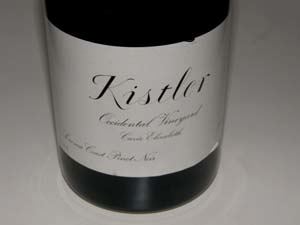 1999 Kistler Occidental Vineyard Cuvée Elizabeth Sonoma Coast Pinot Noir 14.1% alc., 168 cases, $85 · Dark reddish-purple color in the glass. A savory nose plush with earthy loam and oak with a hint of floral perfume. Bigboned and fruity with moderate sinewy tannins. The blackberry and cassis fruit is linear and a bit flat. Soft and smooth in texture. Good.
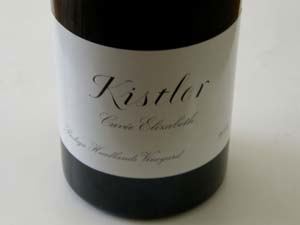 2000 Kistler Occidental Vineyard Cuvée Eilzabeth Sonoma Coast Pinot Noir 14.1% alc., 278 cases, $90. · Very dark reddish-purple color in the glass. Initially, there are some nice dark fruit and exotic fruit aromas but these fade quickly leaving a perfume of herbal oak and green garden. On the palate, the fruit fades quickly, leaving a core of dry, slightly viscous uninteresting fruit with moderate supporting tannins. Decent.
2001 Kistler Kistler Vineyard Cuvée Catherine Russian River Valley Pinot Noir 14.1% alc., 258 cases, $80. · Aromas of exotic woods, spiced fruits and oak. Charming berry and stone fruits with hints of spice and toasted brioche. Flamboyant tannins but vivid and crisp with an appealing tartness due to lively acidity that highlights the fruit. Very good.
2003 Kistler Cuvée Catherine Russian River Valley Pinot Noir 14.1% alc., 516 cases, $90. · There are some very attractive red and black cherry aromas which are slightly roasted. Thick and concentrated flavors of cherry cola and black currants with an undertone of smoky oak. Moderate dry tannins persist long with a refreshing grip of acidity on the bright and citrusy finish. Good.
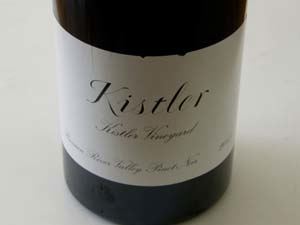 2003 Kistler Kistler Vineyard Russian River Valley Pinot Noir 14.1% alc., 1,790 cases, $75. · Dark reddish-purple hue in the glass. Complex aromatic profile of Bing cherries, dark berry jam, herbal oak, cut flowers and Moroccan spice. A plethora of tasty, sweet dark Pinot fruits including sassafras with a hint of tar and cola. Thick, almost viscous with moderate tannins and a tangy finish bright with cherries and citrus. A big wine that will please hedonists. Good.
2004 Kistler Sonoma Coast Pinot Noir 14.1% alc., 1,328 cases, $60. · Moderate ruby-purple color in the glass. Complex aromatic profile featuring black cherries, cola, prickly pear, baking spices. sandalwood and a subtle vegetal note. Tasty cherry cola and raspberry flavor with some persistence on the finish. Showing a little bit of an aged patina and not as weighty as the Kistler cuvée bottlings. The tannins have melded and the wine is drinking nicely. Good.
2004 Kistler Occidental Station Vineyard Cuvée Catherine Sonoma Coast Pinot Noir 14.1% alc., 1,032 cases, $90. · The nose never delivers much fruit, offering primarily scents of biscuit, oak spice, damp earth and a green note. The fruit trends to the overripe side with raisiny flavors. The pure intensity of the fruit lingers on the finish which has a bright citrus tang. Decent.
2004 Kistler Bodega Headlands Vineyard Cuvée Elizabeth Sonoma Coast Pinot Noir 14.1% alc., 1,024 cases, $90. · Aromas of dark berry jam, oak spice and baked bread. Big and tannic with a profuse array of blackberry, plum sauce and black currant flavors. The fruit flavors are buried in the massive structure. This will always be a tannic wine. Rather uninteresting. Decent.
2005 Kistler Occidental Station Vineyard Cuvée Catherine Sonoma Coast Pinot Noir 14.1% alc., 1,032 cases, $90. · A very alluring nose of black raspberries and spice box. Delicious dark red fruit core that is rich and full-bodied. The tannins and acidity are reigned in and this charming wine has impressive harmony. Very good (+).
2005 Kistler Bodega Headlands Vineyard Cuvée Elizabeth Sonoma Coast Pinot Noir 14.1% alc., 274 cases, $120. · The nose is brooding with little fruit, offering mainly aromas of oak char and smoke. A prodigious and muscled super-sized Pinot Noir that is Syrah-like. There is very little charm to be found here in the dense dark fruit and substantial tannins. A husky wine that needs a good fatty steak. Decent.
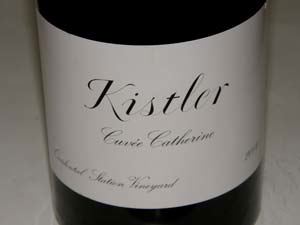 2006 Kistler Occidental Station Vineyard Cuvée Catherine Sonoma Coast Pinot Noir 14.1% alc., 528 cases, $90. · Moderately deep reddish-purple color in the glass. Demure black fruits on the nose with a prominent earthy, forest floor scent. Alcohol peaks out over time in the glass. Delicious dark berry fruit core that is vivid and juicy and persists on the pleasing finish. A big wine but not as chiseled or muscular as previous vintages. Moderate tannins and a smooth mouth feel. Drank nicely the next day from a previously opened and re-corked bottle. The best wine in this vertical tasting. Very good (+).
Halleck Vineyard: “My Three Sons”In 1980, Ross Halleck founded the marketing agency, Halleck Design Group, to assist such Silicon Valley technology giants such as Hewlett-Packard and Sun Microsystems. Halleck later enlisted clients in the Northern California wine industry such as Beaulieu, Iron Horse and St. Supery. Drawn by the allure of the wine business, he moved to Sonoma County in 1991 with his wife Jennifer and their three sons, Connor, Adam and Quinn. Buoyed by Jennifer’s experience and interest in winemaking and wine retailing and the couple’s shared passion for wine, they planted a 1-acre Pinot Noir vineyard behind their home in the hills in southwestern Sebastopol in 1992 and 1993, with the intent to set aside profits from this vineyard to help fund their three sons’ college educations. Planted to Dijon clones 115, 667 and 777, this vineyard was first harvested in 1999. The grapes were sold in 2000 and 2001 to Tandem Winery, with the first Estate Pinot Noir under the Halleck Vineyard label appearing in 2002.
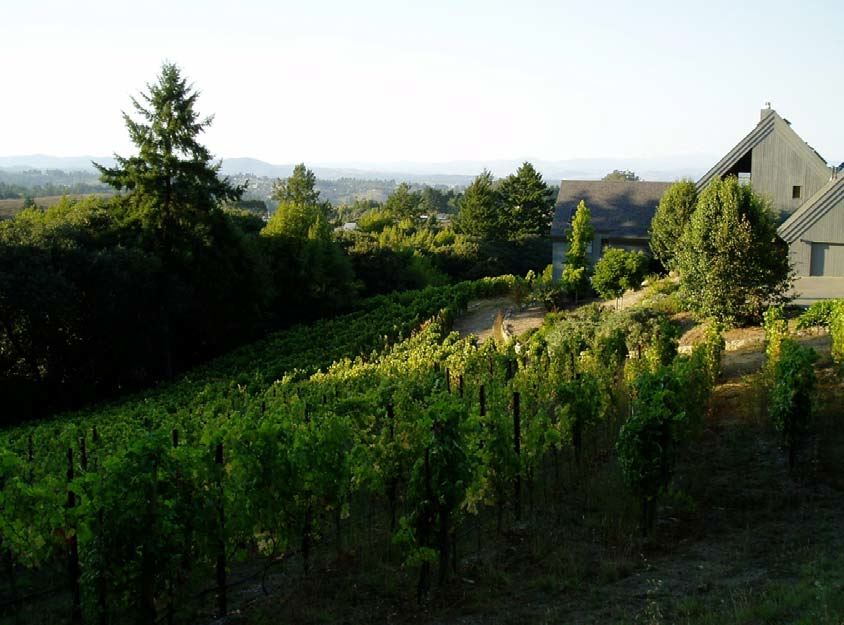 The Halleck Estate Vineyard lies in a region of southwestern Sonoma County that noted Pinot Noir authority John Winthrop Haeger spotlighted in a SFGate.com article in 2008 titled, “Sebastopol’s Hilly New Haven for Pinot Noir.” (www.articles.sfgate.com/2008-08-29/wine/17122232_1_russian-river-valley-greg-la-follettesonoma- county/3). According to Haeger, “Sebastopol Hills is a roughly triangular chunk of land consisting mostly of northeast and southwest oriented ridges on the lee side of a transverse ridge that separates the Russian River Valley from the Petaluma Gap. It is also the main watershed for Arastradero Creek. Though the area has not even been proposed as an official wine appellation, growers and winemakers sometimes talk about Sebastopol Hills as if it were.” The Pinot Noirs from this region are distinct from those grown in the general Russian River Valley, Green Valley, Petaluma Gap and Sonoma Coast. Winemaker Rick Davis was quoted in the article as saying, “Sebastopol Hills Pinots show darker fruit, more earth and more masculinity. They are a bit more masculine and have a bit more mid-palate weight.” Haeger notes, “In tastings, Sebastopol Hills Pinots demonstrate a preponderance of earthy and savory elements with unusual notes of salt marsh, iodine and pepper, and undertones of sober, dried fruit - a marked contrast to the exuberant fresh fruitiness that often typifies Russian River, and the wild, exotic, garrigue-like flavors that often mark wines from the true Sonoma Coast.” Beginning in 2003, the Hallecks expanded their Pinot Noir offerings by sourcing fruit from other nearby premium vineyards. A Three Sons Cuvée was introduced in 2003 which included fruit from the Hallberg and The Farm vineyards. Separate vineyard designated Hallberg and The Farm Pinot Noirs appeared in 2005. The three 2005 Halleck releases were exuberantly reviewed in the PinotFile (www.princeofpinot.com/article/17/). A Clone 828 bottling appeared once in 2006 and a Hillside Cuvée was added to the lineup in 2007. The initial winemaker was Greg La Follette, later replaced by a protege, Rick Davis (Londer Vineyards, CalStar), beginning with the 2005 vintage. Jennifer spent time working at Tandem Winery with La Follette and she has been a capable assistant to Davis. Winemaking is similar for each of the Halleck Pinot Noirs with modifications employed as each wine dictates. Grapes are picked at night, hand-sorted and de-stemmed. A 5-day cold soak is followed by whole berry fermentation in open-top fermenting bins. A portion of whole cluster is used if appropriate stem ripeness dictates. Generally, 30% new and 30% 1-year-old French oak barrels from several coopers are used for aging. Once the blends are in tank, an oak profile is applied to each new blend. The wines are bottled 6 months after blending. At bottling, the wines are neither fined or filtered. Halleck Vineyard Pinot Noirs are sold through the winery’s online store (www.halleckvineyard.com). There is generous distribution to restaurants and retailers throughout the United States. A Sauvignon Blanc and Gewürztraminer are also produced. The winery has an active event schedule including trips that are offered to fans of the winery who are welcomed to connect with the Hallecks. People travel from all over the country to participate in Halleck’s harvest. The Halleck Vineyard Wine Club offers members many perks including free tickets to the winery’s parties and events. Production varies with the vintage, but is approximately 1,500 cases annually. The family recently at their favorite Pho haunt are pictured below.
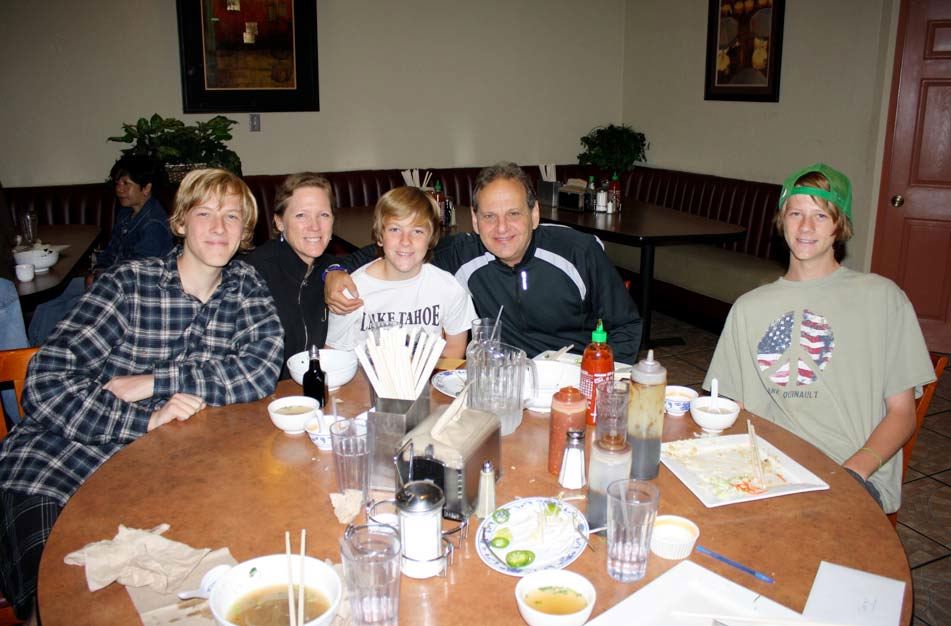 I reviewed two of the 2007 Halleck Vineyard Pinot Noirs over a year ago and the young wines understandably hadn’t quite come together. I recently sampled the lineup of four 2007 Halleck Vineyard Pinot Noirs and came away very impressed with the rich flavors, admirable finesse and overall polish of the wines. Halleck is now in the upper echelon of Sonoma County Pinot Noir producers and the Pinot Noirs are definitely worthy of your utmost attention. In 2007, there is also an Estate Grown Sonoma Coast Pinot Noir ($75).
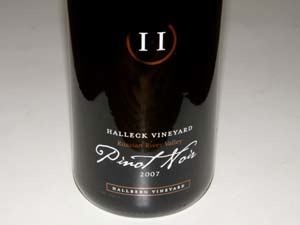 2007 Halleck Vineyard Three Sons Cuvée Russian River Valley Pinot Noir 14.1% alc., $36, released August 13, 2008. Sourced from The Farm and Hallberg vineyards. Clones 115 and 777. Aged 9 months in 30% new French oak barrels. · Lovely aromas of Bing cherry essence and spice. Tasty dark cherry and brown spice core with faint oak in the background. Very charming with some persistence on the dry finish. This wine grabs you and says, “Drink me now.” Very good.
2007 Halleck Vineyard Hillside Cuvée Sonoma Coast Pinot Noir 14.8% alc., $45, released August 14, 2008. Sourced from vineyards in the Sebastopol Hills. Aged 10 months in 30% new French oak barrels. · The nose is quite savory with aromas of dark fruits, forest floor and subtle oak. A charming wine that successfully pushes the ripeness envelope offering copious flavors of grilled dark fruits, cassis and mushrooms. This wine is all about ripe enticing fruit with soft, supportive tannins and bright acidity that brings the drinker back for another sip. Very good.
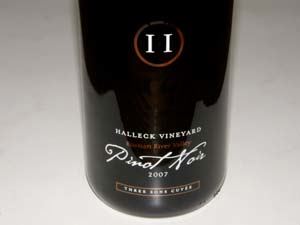 2007 Halleck Vineyard Hallberg Vineyard Russian River Valley Pinot Noir 14.5% alc., $55, released January 15, 2008. Hallberg Vineyard is a former apple orchard located off Highway 116 near downtown Sebastopol. Clones 115 and 777. Aged 10 months in 30% new French oak barrels. · A comforting and welcoming aromatic profile featuring vivid spiced plums and black raspberries. The mid-palate attack is joyously filled with deep black raspberry, dark cherry, and plum sauce intensity. Rich and full-flavored but polished and smooth in the mouth. This wine speaks softly but makes an impression. A fruit-filled fist in a velvet glove.
2007 Halleck Vineyard The Farm Vineyard Russian River Valley Pinot Noir 14.1% alc., $55, released January 15, 2008. From a 2-acre vineyard planted in 1999. Clone 777. Aged 9 months in 30% new French oak barrels. · Nuanced perfume of black cherries, underbrush, seasoned oak and a little barnyard. Ripe and tasty darker cherry and berry flavors with an earthy, peppery undertone, wrapped in ripe dry tannins. Impressive finesse on the palate. Very good.
B.R. Cohn Winery: Noted Cab Producer Releases Stellar PinotWinemaker Tom Montgomery joined B.R. Cohn Winery in 2003 and has continued the tradition of award winning wines that follow in the tradition of those made by previous B.R. Cohn winemakers including Helen Turley and Merry Edwards. After obtaining a degree in enology from California State University at Fresno, he spent time at the original Napa Cellars, Cosentino and Conn Creek before joining B.R. Cohn. Montgomery also crafts a Pinot Noir for Valerie’s Vineyard, one of my personal favorite Carneros Pinot Noirs (www.princeofpinot.com/winery/811/).
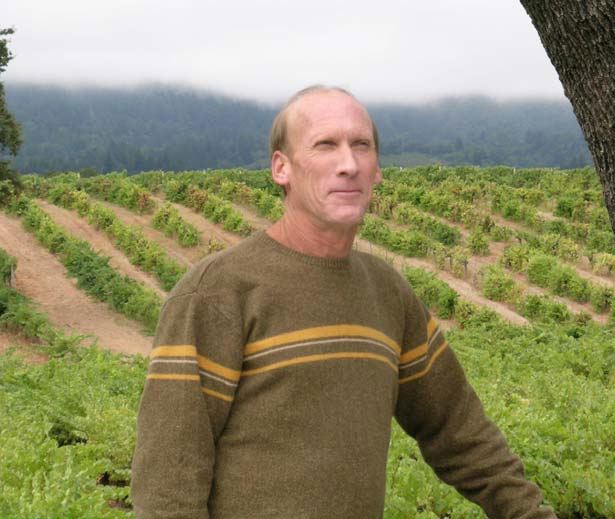 B.R. Cohn, founded in Sonoma Valley in 1984 on land originally acquired by founder Bruce R. Cohn in 1974, is best known for its Olive Hill Estate Vineyard Cabernet Sauvignon and perhaps the extra-virgin olive oils produced there. The French Picholine olive trees planted in the mid 1870s surround the estate, giving the inspiration for is name, Olive Hill Estate Vineyards. As a pinotphile, it was a 2008 Russian River Valley Pinot Noir from B.R. Cohn that really caught my attention.
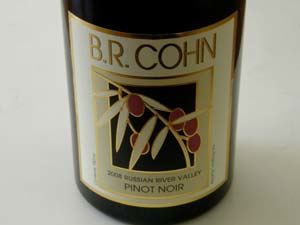 2008 B.R. Cohn Russian River Valley Pinot Noir 14.5% alc., pH 3.64, 1,700 cases, $40. Sourced from Lera’s Vineyard (33%), Dutton Vineyard (30%), Rochioli Vineyard (19%) and Simon Oliver Vineyard (18%). Clones are Pommard, 667 and 777. Cold soaked 4 to 5 days. Whole berry and whole cluster fermentation in 3 and 5 ton open-top fermenters with indigenous and Assmanshausen yeasts. Aged for 18 months in 64% new and 36%1-year-old Francois Frères, Louis Latour and Rousseau oak barrels. Unfiltered. · Moderate reddish-purple color in the glass. Terrific nose replete with slightly confected fresh Bring cherries and allspice. Delicious essence of ripe cherries and strawberries accented by flavors of cherry cola, spice cabinet, and Red Vines. Elegant and seamless with deft use of oak, a silky smooth texture, and a finish that sails along. Très Russian River.
B.R. Cohn Winery and Olive Oil Company tasting room is housed in a building once used as a stagecoach stop for Wells Fargo, where horses on their route from Santa Rosa to Sonoma stopped to be watered and formerly was the home of winery owner Bruce Cohn. The tasting room is open daily and tours are offered by appointment (800-330-4064, ext 124). The Russian River Valley Pinot Noir is available on the winery website at www.brcohn.com.
Big Basin Vineyards: A Special Site in the Santa Cruz MountainsBradley Brown and Samantha Shakti-Brown founded Big Basin Vineyards in 1998 on a historic vineyard site in the Santa Cruz Mountains next to Big Basin Redwoods State Park. The couple renovated this property where French immigrants farmed grapes nearly 100 years ago and planted their first vineyard (Rattlesnake Rock) ten years ago. They built a winery in 2003 using local redwood lumbar harvested from the estate. It stands where the original house, circa 1890, burned down in the 1970s. Over 90% of the estate has been preserved in its natural state. A tasting room, which also houses an impressive art gallery, was opened last month at 14598 Big Basin Way in Saratoga and receives wine enthusiasts daily.
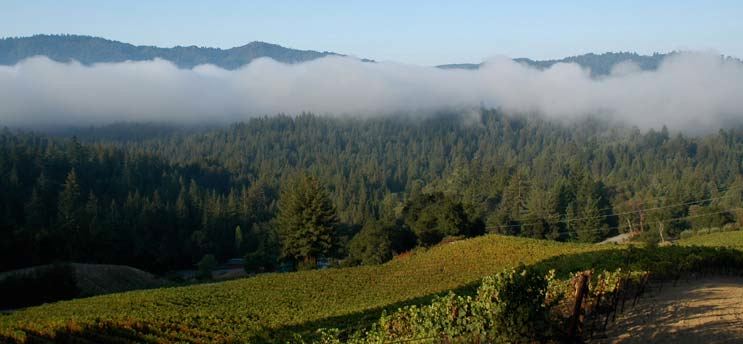 Bradley Brown’s focus is on Syrah (one of Wine Spectator’s ten “Promising New Producers” making Syrah in California), but he crafts some highly respectable small production Pinot Noirs from exceptional sites in the Santa Cruz Mountains. I admire the restrained and balanced style of the wines.
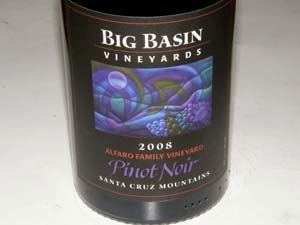 2008 Big Basin Vineyards Alfaro Family Vineyard Santa Cruz Mountains Pinot Noir 14.1% alc., 105 cases $48, release date spring 2011. Sourced from the Alfaro Family Vineyard in Corralitos, located less than five miles from Monterey Bay and exposed to frequent foggy mornings. Dijon clones. 20% whole cluster, whole berry indigenous yeast fermentation. Aged for 14 months in 60% new French oak barrels. Unfined and unfiltered. · Moderate reddishpurple hue in the glass. Persistent and penetrating aromas of strawberries, raspberries, mocha and toasted brioche. Flavorful core of vivid cherries and berries with layered hints of toast, raisin, spice and anise. The fruit is wrapped in gossamer tannins and the finishing fruit grabs hold and lingers. Beautifully crafted with admirable harmony and pinotosity. Will get even better with more time in the bottle. Actually tasted better the next day from a previously opened and re-corked bottle. Very good (+).
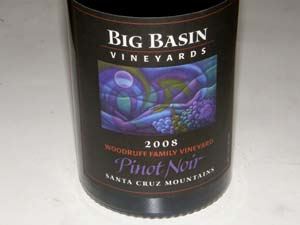 2008 Big Basin Vineyards Woodruff Family Vineyard Santa Cruz Mountains Pinot Noir 14.6% alc., 70 cases, $48, released fall 2010. This vineyard is located in the Corralitos area at the southern end of the Santa Cruz Mountains chain and was planted in 1988. 30% whole cluster, whole berry, indigenous yeast fermentation. Aged for 14 months in 66% new French oak barrels. Unfined, unfiltered. · Moderate reddish-purple color in the glass. The wine is young and tight, offering little fruit on the nose at present. There is some charming dark red berry fruit evident that is nicely framed by oak and persists on the soft finish. The mouth feel is smooth and seamless. I like this wine for its finesse and potential and would like to revisit this wine after a year in the cellar. The wine tasted a slight bit better the next day from a previously opened and re-corked bottle. Good.
Big Basin Vineyards wines are available at the winery and through a mailing list (www.bbvin.com). The wines are also offered at many well-known California restaurants (see list on the winery’s website). Brian uses no foil or wax coverings on his bottles, believing they serve nothing more than a cosmetic purpose, may conceal problems with the cork, and are ecologically unfriendly. Samantha Brown offers regular weekly yoga classes at Shakti Yoga Shala in a room above the winery by appointment (408-318-2900).
Pinot BriefsTaste of Sta Rita Hills A new tasting room opened recently in the Lompoc Wine Ghetto at 1505 E. Chestnut Ave. in Lompoc. The hours are 11:00 AM to 4:00 PM Thursday through Sunday and by appointment. Participating wineries include Moretti Wine, Brewer-Clifton, Clos Pepe, Diatom, El Rey, Gypsy Canyon, Huber, Prodigal, Sea Smoke and Thorne. A select number of wines from these producers are available through the website at www.tasteofstaritahills.com. Loring Wine Company Tasting Room LWC has opened a new tasting room in the Lompoc Wine Ghetto. Hours are 12:00 PM to 5:00 PM Friday through Sunday and by appointment (805-742-0478). Visit www.loringwinecompany.com for a map. LWC has also updated their website for the better. iPad Restaurant Wine Lists Restaurants from Australia to England to the United States are experimenting with iPad wine lists that allow diners to search for wines by name, region, varietal and price as well as viewing information on vintners, vintages and finding wine scores. Interactive wine lists have been successful at a number of restaurants for several years, but the iPad, because of its size and ease of use, has popularized the trend. Wine Filling Stations In some supermarkets in France, customers can fill up their own resealable containers at vending machines with pumps fashioned after those used in gas stations. Simply insert your money or credit card, select your grade (red, white or rosé), pump your wine and print a receipt. The idea resembles the practice years ago in Paris where consumers would bring their own flagons to fill from barrels delivered by wineries. www.likecool.com/Wine_Filling_Station--News--Gear.html.
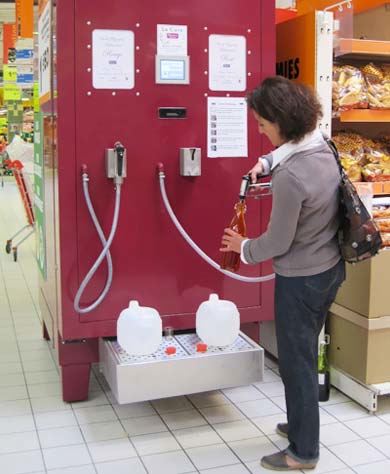 Grand Opening of Inman Family Winery On September 25 and 26, 2010, the new Inman Family winery located at 3900 Piner Road in Santa Rosa will have a celebratory weekend. An ecologically friendly tasting room is the center point. All the wood for the cabinets and tasting bar were salvaged from the old barn that was taken down to build the new winery. Inman Family Wines was founded in 2000 with the planting of the organically farmed Olivet Grange Vineyard. The winery specializes in Pinot Noir, Pinot Gris, Rosè, and most recently, Chardonnay. The wines, crafted by Kathleen Inman, are consistently stellar. A lovely aged farmhouse on the property is available for rental. Visit www.inmanfamilywines.com for more information. Navarro Wildfire Offering Since 1977 Indian Creek has been Navarro’s label for odd lots of wine with low prices. Because of the wildfires in the summer of 2008, Navarro’s red wines have a smoky undertone that is uncharacteristic of Navarro reds. Because these wines have developed this uncharacteristic nuance, Navarro is offering all remaining 2008 Navarro produced red wines under the secondary Indian Creek label at savings up to 65%. The entire 2008 Méthode à l’Ancienne Pinot Noir has been labeled as Indian Creek Reserve Pinot Noir ($78 for a 6 bottle pack) and Navarro’s 2008 Mendocino Pinot Noir is now relabeled as Indian Creek Pinot Noir ($60 for a 6 bottle pack). Order at www.NavarroWine.com.
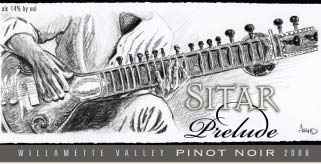 Sitar Wines Debuts Sitar Wines is the newest addition to the Revana Family Vineyard family of wines.The inaugural release is the 2008 Sitar Prelude Willamette Valley Pinot Noir crafted by noted winemaker Tony Rynders and featuring a label created by renowned artist Thomas Arvid. The wine is limited to 300 cases per year and allocated in six pack collector’s boxes which display Thomas Arvid’s original charcoal drawing ($100 a bottle). Over five vintages, each new Sitar label will feature Arvid’s artistic process as he progresses from charcoal to completed oil painting on the 2012 vintage. For information contact Director of Sales & Marketing Todd Newman (Todd@revanawine.com) or Hospitality and Sales Manager Nathalie Vaché (Nathalie@revanawine.com).
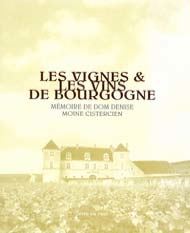 Scott Paul Releases Dom Denise Pinot Noir Scott Wright has made an experimental lot in the 2008 vintage from 4 tons of fruit from Momtazi Vineyard and vinified half of it following Dom Denise’s protocol from the 18th century, and the other half following the usual winery practices. The winery staff ended up like the Dom Denise version so much they bottled it separately. Dom Alexandre Denise was the Cistercian monk in charge of winemaking at Burgundy’s Chateau du Vougeot in the mid 1700s. He kept detail notes and records of his work and Wright was inspired upon discovering and reading his book. 100 cases produced, $40. Visit www.scottpaulwines.com. Debate on Breast Cancer and Alcohol Link Continues Two recent epidemiological studies have been published indicating the relationship between alcohol and breast cancer is very complex and still needs clarification. One study found that women who drank one or more drinks per day had double the risk of lobular type breast cancer (10-15% of all breast cancers are lobular), but no increased risk for ductal type breast cancer (70% of all breast cancer cases are ductal). A second study found a possible reduction in risk of breast cancer for women with the gene mutation BRCA1 who drank moderately, but not for women with the BRCA2 mutation. The reduction in risk was only for those who consumed wine who had an 18% lower risk than nondrinkers. Pinot American Brasserie Opens in Portland In August of this year, Pinot American Brasserie opened in the platinum certified LEED building at 120-5 S.W. Washington Street. Pinot Noir is the favored libation here with a wine list that totals almost 200 entries dominated by Oregon Pinot Noirs. The website is www.pinotpdx.com. Other restaurants in Portland with wine lists stocked with Oregon Pinot Noir include Bar Avignon, Blue Hour, Davis Street Tavern, The Farm Cafe, The Heathman, Higgins, Meriwether’s, Paley’s Place, Park Kitchen, RingSide, Ten 01, Urban Farmer, and Wildwood. Donum Announces Pre-Release of Thomas Pinot Noir Thomas is named after Thomas Ferguson, the owner of Ferguson Vineyard, a 1974 planting of Martini clone Pinot Noir adjacent the Donum Estate. In 2008, Mr. Ferguson celebrated his 100th birthday and this special bottling commemorates the occasion. 100 cases were made from this special site priced at $100 a bottle. Visit www.thedonumestate.com. Jean-Charles Boisset Opens Taste of Terroir This new stylish tasting salon has opened on the Healdsburg Plaza in a space previously occupied by Gallo Family Wines. Visitors have the opportunity to try wines from Boisset-held properties in Sonoma (DeLoach Vineyards), Napa (Raymond Vineyards) and Burgundy (Domaine de la Vougeraie, Jean-Claude Boisset, Jaffelin, Bouchard Aine & Fils and J. Moreau & Fils.) Consumers can also purchase a French oak miniature wine barrel with a tap and vacuum-sealed bag of wine offered as DeLoach Vineyards Barrel to Barrel. Read more at www.pressdemocrat.com/article/20100824/ LIFESTYLE/100829836. Alcohol Fee Passes in San Francisco An alcohol fee to help pay for the care of San Francisco’s inebriates was passed by the Board of supervisors this month. This is the first of its kind in California and was met with instant opposition including Mayor Gavin Newsom who vowed to veto the proposal.
Pinot Legs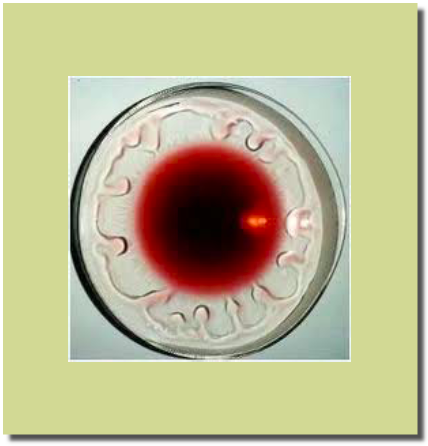
I was tasting wine with several others awhile back and one of them exclaimed after swirling their glass, “This wine has great legs.” This statement is often interpreted as a compliment or a confirmation of quality, but “legs” that are observed on the inside of a wine glass are related to the alcohol level and not in any way related to quality. In truth, what one is really saying is, “This wine has plenty of alcohol.” The higher the alcohol, the more noticeable are the legs. According to Emile Peynaud, author of The Taste of Wine, when you swirl a wine glass, a clear film creeps up the sides of the glass above the wine’s surface and forms droplets which then fall. Often called legs, they are also referred to as tears, arches or arcs. The Germans called them Kirchenfenster or church window because they resemble Gothic arches. The scientific basis for legs is called the “Marangoni effect.” Alcohol is more volatile than water and the alcohol (not glycerin as many wine drinkers claim) condenses on the glass. Wine has a number of other anatomic parts including a “nose” and “body.” The nose refers to aromas smelled in young wines and the bouquet of smells acquired with aging. Body refers to the concentration of a wine. A substantial wine is said to have “good body.” Be careful with the use of this phrase, for “a good body” means something entirely different. Sugar, alcohol, glycerol and tannins contribute to the body of a wine. It should be remembered that a full-bodied wine does not necessarily equate with quality. Wines may have a “robe” as well. This term is frequently used to refer to the color or shade of a wine. |